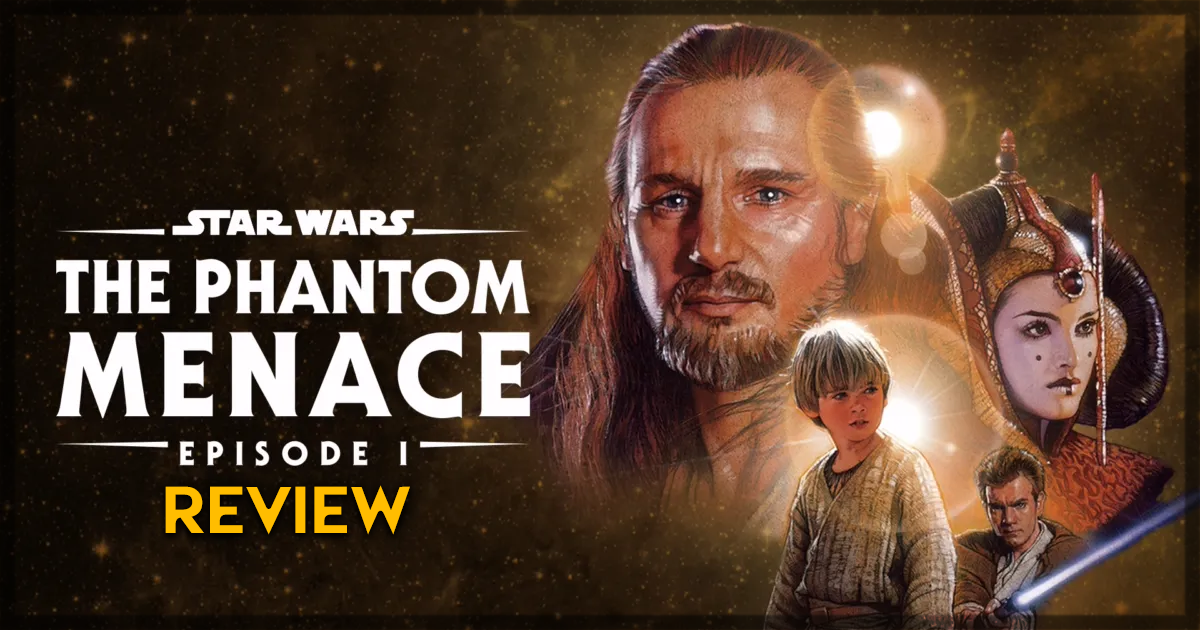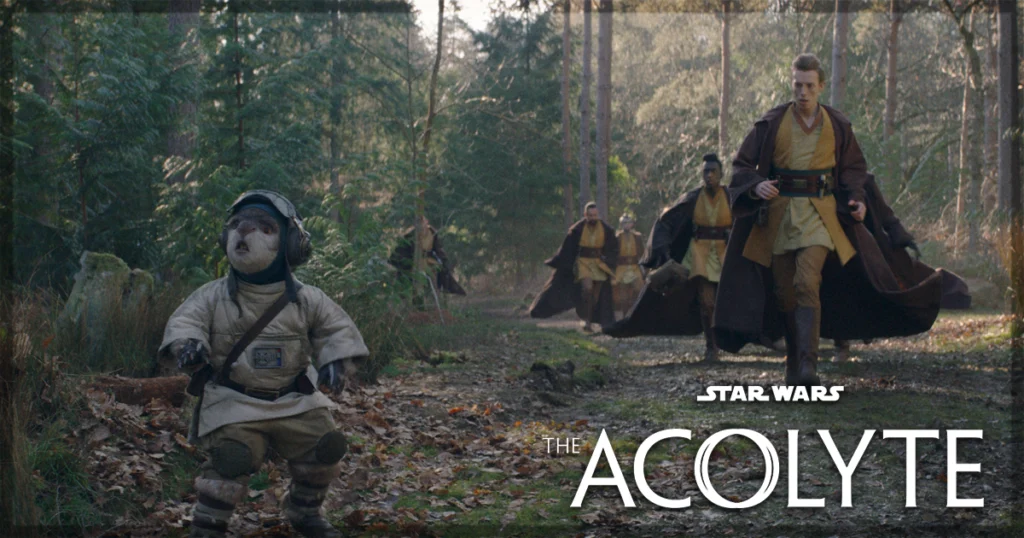When Star Wars: The Phantom Menace, the first of the Star Wars prequel trilogy, hit cinemas in 1999, it proved extremely divisive. A definite victim of overhype, with some fans literally camping outside cinemas before the first screening, neither critics nor audiences seemed to agree on the film’s quality. The reality is more nuanced. One’s enjoyment of The Phantom Menace will likely depend on if they can better see the forest of its ambition or the trees of its shortcomings.
A long time ago, in a galaxy far, far away, the Jedi order kept peace for the Galactic Republic. They are a religion of warriors who suppress attachments and wield ubiquitous powers called The Force. Peace is threatened when the greedy Trade Federation invades the planet of Naboo. Two Jedi, Qui-Gon Jinn (Liam Neeson) and his padawan Obi-Wan Kenobi (Ewan McGregor) rescue Naboo’s elected officials and begin orchestrating a plan to liberate the planet. During their travels, they encounter a young slave boy on the planet Tatooine, Anakin Skywalker (Jake Lloyd), whose strength in The Force is unusually strong, as well an agent of the Sith, dark Force-users whose leader, Darth Sidious (Ian McDiarmid) is secretly pulling the strings of the entire conflict.
Some of the reactions to The Phantom Menace can be attributed to mismanaged expectations and even a sense of entitlement regarding the original films – attitudes that would rear their ugly heads once again with the release of Disney’s sequel trilogy. Star Wars was as big a cultural titan in 1999 as it is today, leading many who grew up with the originals to put the franchise on a frustratingly high pedestal. It’s part of the reason why navigating the Star Wars fanbase, and its abundance of toxicity, is so exhausting. The Phantom Menace, in fairness, doesn’t possess the highs of the originals. In fact, it contains a myriad of flaws. But, when taken on its own terms, it does offer grand imagination and deceptively intriguing themes.
George Lucas, who conceived the story for the original trilogy, returns to the director’s chair for this film, his first time directing since the first Star Wars in 1977. This creates a strange irony – the director of one of cinema’s most celebrated blockbusters was still relatively green. That naivety translates into many of the film’s weakest elements, namely its script. For someone so unequivocally skilled at visual storytelling, Lucas’s dialogue is blunt and bogged down by exposition. The film is plagued with tedious political discussions, while the positions and ambitions of the characters are told to us rather than experienced. The story will contain thrilling spectacles, such as the Tatooine pod race sequence, only to follow them up with sizable stretches of boredom where emotions and stakes are explained rather than seen or felt. This affects many of the performances, which aren’t bad per se, but have a tough time selling the emotional components of their roles due to the mechanical nature of the writing. Only a handful of the actors are able to work within these confines, particularly Neeson and McGregor, who turn in sage and fun performances respectively.
The Phantom Menace is an ensemble piece, with arguably no central protagonist in the way that Luke or Rey were in their own Star Wars trilogies. The characters – be it Qui-Gon, Obi-Wan, Anakin or Padme Amidala (Natalie Portman) – are united by their goal of liberating Naboo, but each have different reasons. Anakin has sensationalized ideas of heroism, born from a life of slavery, while Padme, as Naboo’s leader, sees it as her solemn responsibility. Qui-Gon and Obi-Wan are only following orders from the Jedi, yet Qui-Gon values emotional attachments – a direct contrast to what the Jedi believe in. His willingness to help Naboo and his respect for the relationship between Anakin and his mother (Pernilla August) showcase this belief. It would’ve been nice to see these philosophies explored visually rather than purely through dialogue, but it does make the characters reasonably engaging.
What this leaves us with is a story about people coming together for a common good – to save their emotional attachments through liberation. Serving this theme of solidarity is bold filmmaking that makes for sweepingly imaginative spectacles. While the abundance of CGI has become more noticeable in recent years, the scale of the worlds detailed and depicted is nothing short of mesmerizing. Whether it’s the underwater colonies of the Gungan race on Naboo or the planet-wide city of Coruscant, the creativity in the production design is awe-inspiring. The visuals feed into the film’s kinetic energy, best captured by the opening confrontation with the Trade Federation, the midpoint pod race, and the climactic battle for Naboo. The colors, scale, and cinematography all come together to create visual enchantment, underscored by a hair-raising score from the legendary John Williams.
The Phantom Menace further lays sufficient groundwork for the overarching themes of the trilogy – namely on how entitlement and the rejection of emotions can lead people astray, as seen by the gradual character arc of Anakin Skywalker. The climactic lightsaber duel between Qui-Gon, Obi-Wan and the terrifically designed Darth Maul (Ray Park) can be seen as a battle for Anakin’s soul, and what philosophy will determine his Jedi training; whether his emotional attachments will be nurtured and embraced by Qui-Gon, denied by the wider Jedi order, or corrupted by the Sith. That most will know the outcome from having seen the original trilogy adds a sense of tragedy to this battle’s resolution. This, on top of John Williams’ accompanying Duel of the Fates track, is what makes it one of the best lightsaber duels in any Star Wars film, as well as an important milestone in this trilogy’s core thesis.
This is all thematically rich material whose impact is weakened by the writing, be it the bloated plot, the anxious reliance on telling over showing or, a particularly grievous error, shoehorned comedy. Even though it can be appreciated by all ages, Star Wars has always been primarily for children. Anyone who tells you otherwise is in denial. But the comedy utilized here feels patronizing and sloppy, with most of the humor placed on the shoulders of the Gungan Jar-Jar Binks (Ahmed Best). His childish, in-your-face antics get very old very quickly. In some instances, such as the battle between the Gungans and the droid army of the Trade Federation, the script’s insistence on gags involving Binks’ idiocy actively undermines the entertainment factor. That Binks, and other characters such as the leaders of the Trade Federation, can potentially be read as racist caricatures, namely due to their accents, does not help either.
When compared to the original trilogy, The Phantom Menace leaves a lot to be desired. It’s messy, meandering, and directorially stunted. Lucas allegedly surrounded himself with a lot of yes men during production, and it’s hard not to believe that, given the end product. Yet one also has to respect its commitment to vision and the ways it manages to generate fun and engagement through otherwise slapdash components. This seems to be Lucas’s unfiltered story, with minimal if any studio or budgetary interference, something that’s difficult to achieve in the film industry. As such, there’s a sincerity to its championing of emotional connections and solidarity. Taking the film as it is doesn’t turn it into a great product by any stretch, but its shortcomings do become easier to tolerate.
Art is not measured by a checklist of what’s good or bad – rather, it is assessed by emotional response and resonance, and this film is so earnest in its desire to entice the imagination that it just about works. Calling The Phantom Menace rough around the edges is an understatement, yet the excitement generated by its ambitious filmmaking, creative setpieces, and deceptive thematic richness are all worthy of admiration. It’s far from the best of the Star Wars saga, but for the right audience member suitably distanced from the rose-tinted glasses of nostalgia, there’s plenty to enjoy.
3 stars
Star Wars: The Phantom Menace (Episode I) is available to watch on Disney+.
Learn more, including how to watch, at the Disney+ site for the title.
You might also like…
‘Star Wars: The Acolyte‘ Review – Episode 8


